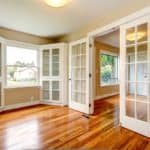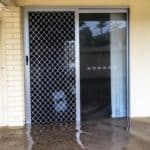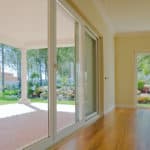Key Takeaways
- Basements can exist without doors, but for safety and accessibility reasons, it’s not advised.
- Reasons for a doorless basement might include ongoing remodelling or use as a storage area where regular access is not required.
- In the absence of a door, ensure safe access via a ladder and maintain good lighting and ventilation.
As a veteran building inspector, homeowners often ask me if it’s possible or advisable to have a basement without a door. This debate stems from the fact that many older homes were built with simple, curtained basement entries or open stairwells leading down into dim, unfinished spaces used primarily for storage.
However, contemporary building codes and safety standards have evolved to require formal ingress and egress to all living areas, including basements. So, while a doorless basement may have sufficed decades ago, I strongly advise homeowners today to understand the legalities and functionality considerations before a proper basement entry door.
In this comprehensive guide, I’ll shed light on when basement doors became standard practice, the safety and energy efficiency benefits they provide, and most importantly – whether it’s legally permitted to have a basement without one in a modern home. I aim to give homeowners, architects, and builders an insider perspective into basement door design so you can make informed decisions about this foundational element.
The Basics of Basement Access
In early 20th-century home construction, basements were considered utilitarian spaces unfit for habitation. Rudimentary curtains or swing gates often sufficed as dividers between the basement steps and the upstairs living space. Even an utterly open stairwell was common.
However, the role of the basement has changed dramatically over the decades. Many contemporary homes use basements as living quarters or rentable units, so a sturdy physical barrier between floors is now standard.
Doors serve several important functions, including:
- Providing insulation from temperature/humidity changes
- Buffering noise transmission between floors
- Enhancing overall safety and security
Compared to curtains or open stairs, a closed door creates an impermeable separation between basement and above-grade areas.
The Functionality of Basement Doors
“A basement door is the number one way to enhance livability and comfort in below-grade spaces. It creates a defined threshold you can secure and insulate.” – Mike, Veteran Contractor
As John highlights, a basement door offers benefits you can’t achieve with curtains or an open stairwell. Let’s examine these advantages:
Insulation
- Doors form an air/moisture barrier, preventing conditioned air from escaping
- Solid doors have far higher R-values than curtains, leading to energy savings
- Weatherstripping seals out drafts, pests, and allergens
Noise Control
- Heavy doors muffle sounds like footsteps and voices transmitting between floors
- Allowing for undisturbed sleep, work, or recreation in the basement
Safety
- Doors can be locked to prevent unauthorized basement access
- Self-closing models inhibit fire spreading from the basement to the upstairs
- Doors create a childproof barrier at the top of the stairs
While these benefits are clear, a potential drawback is reduced accessibility. Occupants must navigate the doorway when moving between floors.
Safety Concerns and Building Codes

“We see retrofits with doorless basement stairs often, but no matter how convenient it seems – this violates code. A basement remodel requires installing an entry door.” – Peter Brown, Building Inspector
As Peter indicates, removing a basement door during a renovation goes against the code. Safety is the prime reason modern standards evolved to require basement doors.
Know the Rules for Finished Basements
Whether retrofitting an existing basement or building a new one, adhering to code is essential. Here are the key requirements:
Emergency Exit
- Bedrooms must have an emergency egress to the outdoors
- Egress windows and window wells provide escape routes
Stairwell
- Stairs must be up to code with proper railings, lighting, and tread width
- Open sides require guardrails to prevent falls
Entry Door
- A self-closing, 1 3/4″ solid wood door is advised
- Must be connected to the central alarm system if present
These measures ensure safe exit paths in case of fire, accident, or emergency. A basement lacking a formal door essentially has an open shaft from the basement to the upper floors – allowing smoke and flames to spread rapidly.
Fire Safety and Prevention
Closed doors are proven to slow fire spread, as explained by the International Association of Fire Fighters:
“A closed door hinders a fire’s growth for up to one hour, allowing extra time for escape and firefighting efforts.”
Without a basement door, this vital protective barrier is lost.
From both legal and safety perspectives, a basement door is essential in any finished or legally habitable below-grade space.
The Debate: Door or No Door?
Despite the clear benefits, some homeowners still debate whether a basement door is necessary – especially if the space is unfinished. Here are some perspectives I’ve gathered from the building community:
“We removed our basement door to open the living room and make moving furniture easier visually. No issues so far.” – Linda, Homeowner
“I’d recommend a basement door even for storage. It prevents humidity and bugs from creeping up, and keeps out dust/allergens.” – Tom, Contractor.
“We use the basement for crafts and hobbies, so we love having an open stairwell for venting fumes. But a swing gate could work for safety.” – Mackenzie, DIYer.
“Open concept is nice, but comfort and efficiency matters too. A basement door lets you control temps and noise.” – Samantha, Architect.
While some homeowners appreciate the convenience and aesthetics of no door, most experts emphasize the functionality benefits. An open stairwell does promote air circulation and ease of moving large items but compromises energy, safety, and noise control compared to having a door.
Making the Decision: To Install or Not to Install

When making this decision in your own home, consider your basement’s particular uses along with the legal and practical implications:
Is there any functional reason not to have a basement door?
- For unfinished spaces used only for storage, a door may seem unnecessary
- During active renovation projects, an open entry allows moving materials to easily
- If using dusty equipment like wood shops, an open stairwell promotes ventilation
- It creates a more spacious, open flow between floors
However, even in these scenarios – a basement door offers worthwhile benefits most times.
Should the basement door be kept closed?
Some homeowners hesitate to add a door, believing it will block the desired airflow between floors. However, consider:
- When closed, doors prevent energy loss far more than a curtain
- With AC or heating, keeping doors closed cuts utility costs
- For kitchens and baths, closed doors contain smells and humidity
- Noise travels readily through open doorways
While you can keep a basement door open when desired airflow or access outweighs other factors, installing the door allows you to close it whenever needed.
Living in a Basement Legally and Comfortably
A door becomes crucial for legal and comfort reasons for homeowners using their basements as living spaces or separate rental units.
If you want to legally finish your basement, ensuring it’s up to fire and safety codes is essential – and that absolutely includes having an entry door installed.” – Mary Jones, Fire Inspector
Mary emphasized that an egress door is mandatory for legal habitation if you want your remodelled basement classified as a bedroom.
Beyond meeting this vital code requirement, a door also enhances livability as a living space by:
- Muffling noise from upstairs to create peaceful bedrooms
- Locking for privacy and security of tenant’s belongings
- Containing HVAC between units for optimal temperature control
- Blocking cooking smells or cigarette smoke from transmitting between floors
For legal compliance and enhanced livability – a sturdy basement entry door is an apparent necessity in any finished basement designed for full-time occupancy.
Can you live in a basement without windows?
While basement windows provide natural light and emergency egress, they are not necessarily required by code if alternative exits are in place. However, a basement door is always mandatory for bedrooms or living spaces.
Enhancing Your Basement
If you’re on the fence about adding a door, consider how it can enhance your basement’s functionality and enjoyment:
What kind of door do I need for a basement?
An exterior-grade solid core wood door at least 1 3/4 inches thick is best suited for basements. Steel-insulated models also work well. Key features to look for include:
- Weatherstripping – Seals out drafts, moisture, and pests
- Insulation – Maintains comfortable temps and reduces energy loss
- Safety hinges – Self-closing to prevent fire spread
- Deadbolt – Allows door to be securely locked
Adding value: Does having a finished basement add value to your home?
Definitely! Remodelled living spaces, bedrooms, kitchenettes, home gyms, media rooms, and game rooms in a finished basement can significantly increase a home’s value. One estimate is around 10-15% ROI for finishing a basement. Having an egress door is part of the meeting code for legal bedrooms or rental units.
What makes a basement finished?
A finished basement is any below-grade space improved for habitation and comfort through qualities like:
- Drywall walls vs exposed concrete
- Dropped ceilings to hide pipes and wires
- Floating flooring over concrete
- Neutral paint colours and trim work
- Adequate lighting, windows, and ventilation
- Egress options to meet bedroom codes
- The entrance door between the basement and upstairs
These features transform raw basements into livable, code-compliant spaces that add value and enjoyment to any home. The entry door is a vital component not to overlook.
Practical Considerations for Basement Doors
For homeowners deciding on adding a basement door, let’s explore practical installation factors:
Can you add a door to the basement?
Yes, cutting an opening and installing a door in an existing basement wall is possible. Here is the process:
- Determine location – Ideally, near stairs for access. Check for wiring/plumbing in the way.
- Cut opening – Use a concrete saw to outline the planned door size. Wear protective gear for dust.
- Install header – A permanent lintel header across the top prevents sagging.
- Frame in rough opening – Use treated lumber secured with concrete anchors.
- Install pre-hung door – Nail door assembly into rough opening per manufacturer instructions.
- Finish trims – Add interior trims and weather sealing for a seamless look.
How to insulate a basement door for energy efficiency
A poorly insulated door results in energy loss and humidity. To enhance efficiency:
- Select an insulated door with a high R-value
- Ensure door seals tightly via weatherstripping
- Use foam insulation sealant around the edges
- Add a draft blocker at the bottom of the door
- Cover any glass panes or openings
With good insulation practices, an exterior-grade basement door will prevent costly heat transfer between floors.
Financial Implications
What are the costs associated with a basement door installation for homeowners watching their budgets?
What is the most expensive part of finishing a basement?
If completing a full basement remodel, the most costly components are generally:
- Framing and drywalling walls/ceiling
- Installing doors, windows and trims
- Running electric, HVAC and plumbing
- Flooring and built-ins
- Labour fees for contractors
The basement entry door is a relatively affordable part of the budget.
Cost considerations: How much does finishing an average-sized basement cost to complete?
According to Remodeling Magazine’s 2022 Cost vs. Value report, the average cost to complete a midrange basement remodel is around $72,000 with a 70% ROI. High-end remodels with full kitchens and bathrooms can approach $150,000. Depending on size, materials, and labour fees, the basement door generally ranges from $200-$1000.
How much does it cost to put a door in a concrete wall?
If only adding a basement entry door without fully finishing the space, you can expect costs between $2000-$4000. This includes cutting concrete, framing the rough opening, purchasing and installing a pre-hung steel door, finishing trims, and adding insulation/weatherstripping. Hiring a contractor is advised over DIY.
While a worthwhile investment in your home’s functionality, a new basement door alone is relatively affordable, especially when done simultaneously with larger remodelling projects.
Permissions and Community Guidelines
For any major construction projects like finishing a basement, be sure to seek the proper permits and approval:
Do you need planning permission to put a door in a wall?
Adding a doorway to your home’s footprint generally doesn’t require planning permission. However, any major renovations, like converting a basement into a separate rental unit, might need approval to comply with safety and zoning regulations. Always check with your local permit office at the start of a basement project to ensure you meet the codes.
Joining the community of building science experts for advice and support
If you need guidance navigating basement improvements, many online communities connect homeowners with building science and design experts. Discuss your plans to receive constructive feedback and cost-saving tips from pros and fellow DIYers.
Maintenance and Upkeep

A basement door requires occasional upkeep to remain functional. Here are some key maintenance tips:
How do I get fresh air in my basement without windows?
Ventilation is important for stale and musty air. Without windows, use:
- Ceiling ventilation fans
- Ductwork connected to upstairs HVAC
- Dehumidifiers to control moisture
- Floor and wall vents bring in outside air
Keeping air circulated prevents mould and mildew buildup.
Managing odours: Do unfinished basements smell?
Unfinished basements prone to dampness can develop musty odours. Fight this with:
- Dehumidifier to control moisture
- Air filtration systems
- Fresh paint over concrete with odor-blocking primer
- Routine cleaning to eliminate mould/mildew
- Cracks/gaps sealed to prevent pests and smells
Proper humidity and ventilation control are key.
Temperature control: Are unfinished basements cold in winter?
Partially, underground basements tend to feel colder. Remedies include:
- Insulating walls, floors, pipes and the entry door
- Space heater to directly warm basement
- Adjust the HVAC system to redirect heat downstairs
- Area rugs over floors to provide warmth
- Thermal curtains over glass block windows
An unfinished basement can feel comfortable year-round with proper insulation and heat sources.
Additional Considerations
A few final thoughts on unique basement door situations:
What are the three types of basements?
The main basement types are:
- Walk-out – A door opens to ground level.
- Look-out – Windows exist at ground level for light.
- Walk-up – Exterior stairs lead down to the door.
Walk-out and look-out basements allow more natural light, but walk-up types work too.
The uniqueness of a basement trap door
Some older homes feature trap doors built into floors as discreet basement access points. These should not replace a full basement door but can serve as an additional passage if needed. Ensure hinges and hardware are sturdy.
Floating walls in basements: Necessity and installation
Floating walls do not bear structural weight and isolate walls from moisture. Installing:
- Use foam anchor sleeves between studs and concrete
- Attach the top plate to floor joists, not concrete
- Allow slight gaps at the bottom for drainage
- Use pressure-treated bottom plates
Float basement walls for easier finishing and insulation.
What Are the Benefits of Having a Basement Without a Door?
Having a basement without doors shorter than 80 inches can offer multiple benefits. It can create an open and seamless flow between the basement and the rest of the house. This can make the space feel larger, brighter, and more connected, and can also improve ventilation and accessibility.
Are French Doors a Suitable Alternative for a Basement Access Point Without a Traditional Door?
When it comes to creating a stylish and practical access point for your basement without a traditional door, french doors in Perth can be a suitable alternative. Not only do they add an elegant touch to your space, but they also provide easy access and allow natural light to enter the basement.
Basement and doors
I recommend constantly installing an entry door if your basement is finished for occupancy – this is mandated by code and best practices. For unfinished spaces, a door still provides substantive benefits in safety, energy use, and pest control, making it advisable for most homes.
Carefully weigh whether any perceived convenience of an open stairwell outweighs the advantages of a weather-stripped, insulated door that can seal off the basement. This barrier improves livability and contains fire spread and fumes in an emergency.
As you remodel or build out your basement, follow local codes and seek professional advice about constructing safe entryways. But in most cases, putting in a high-quality door is one improvement that will pay dividends for your home’s functionality and comfort over the long term.

I’m James Davis, a carpenter with eight years of experience in carpentry services, repairs, installations, renovations, and maintenance of interior doors. I have a diploma in carpentry and joiner trade from the Education Skills Australia Institute and take pride in delivering high-quality results to ensure customer satisfaction. I’m a blog writer for Octopus Doors Company and enjoy sharing my knowledge and tips on maintaining security measures and choosing the right door materials, paints, or handle styles. I specialize in custom-made interior doors and strive to make every home look fabulous. Contact me anytime for help with door-related issues.











